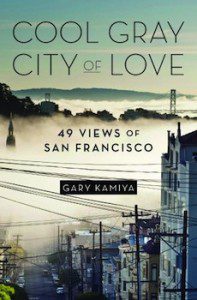
I was out in Point Reyes one day, stumbling around the beaches looking for fog. There was no fog that day, just sun and sand, so after a time I retreated to Point Reyes Station and found myself in the little bookshop on the main street. In the back, in or around a section reserved for local history, I found an old hardcover copy of a book I had never heard of, written by Harold Gilliam in 1957. (Had I grown up in the Bay Area, no doubt I would have recognized Gilliam’s name; he wrote for the Chronicle for many decades.)
Gilliam’s book is titled, simply, San Francisco Bay. Behind the prosaic title hides a lyrical account of the city’s history and the natural world that surrounds and engulfs it. It’s a great book, and since that first reading I’ve often wondered why it hadn’t been rereleased for a new generation of readers. (A fifty-year anniversary edition would’ve been nice.)
Luckily, we have Gary Kamiya’s Cool Gray City of Love: 49 Views of San Francisco, another lyrical history of the city very much in the tradition of Gilliam’s San Francisco Bay. A city like San Francisco can never be truly known by one person, not all of it, but Kamiya probably knows as much about the city as anyone. He was born in Oakland in 1953 and has lived in San Francisco since 1971. He’s clearly read every book about San Francisco he could track down. (The bibliography alone is interesting reading for fans of obscure San Francisco history.) Kamiya was also a cab driver in the ’70s, which gives him a unique perspective on the city, and now he spends much of his time, it seems, walking around the city for kicks.
To tourists, transportation in San Francisco means cable cars—and maybe at one point that was accurate—but the city cannot be known at all if not on foot. San Francisco is a great walking city, whether you’re simply walking from your apartment to the closest BART station, or you’re meandering lost staircases on some infrequently traveled hill for hours. Kamiya has walked much of the city, and Cool Gray City of Love feels very much like a grand walking tour.
Kamiya tells us that his book is written in the spirit of Katsushika Hokusai’s woodblock prints “36 Views of Mt. Fuji” (circa the 1820s). “Hokusai depicted the great mountain from a variety of perspectives,” Kamiya explains, “from the sea, across the plains, with pilgrims in the foreground, through a screen of trees.” Cool Gray City of Love attempts to do the same thing for San Francisco. Sometimes the city is a rock floating alone in the ocean; sometimes it’s the human depravity of drug addiction and forced prostitution and homelessness; sometimes we humans are paving over the natural world, and at other times we are trying to revive it.
The structure of Kamiya’s Cool Gray City of Love may be a bit disorienting to some readers. He starts, for example, at the Farallon Islands, 30 miles west of the city—and a place many San Franciscans wouldn’t even recognize as the city—and then jumps in the second chapter to the seedy Tenderloin district. For Kamiya, “[t]his kaleidoscopic approach is an attempt to capture the visceral, spatial experience of moving through the city while simultaneously relating her history and my own journey.” It can be jarring, perhaps, but it’s never boring.

For anyone who has walked San Francisco, this method will be recognizable. It is the Victorian next to the modern glass-and-steel condo, the wind-swept summit of Twin Peaks with the congested traffic in view below. One of the great joys of the city is the constant stream of juxtapositions. Everything is in flux: the world being built and destroyed, life awakening and dying off, a veil of fog hiding everything in front of you and then revealing a glimpse of something just beyond it.
With the recent influx of tech money, San Francisco is at a turning point, or a crossroads, or might even be at war with itself. (Your metaphor of choice may betray which side of the war you are on.) Many in the old guard are dismissive of the new arrivals—“they” know nothing of San Francisco’s history and see little of the present-day city even as they live in it—“they” spend all their lives in office buildings and Uber town cars and swanky bars.
As prices rise, changes to the city are unmistakable. Artists, nonprofit workers, and teachers are leaving. (Most working-class San Franciscans had already left before the most recent influx of money.) It’s enough to make anyone who’s been here more than a few years want to yell: “STOP!”
But anyone who wants to preserve this city exactly as it is at any one moment is misreading the city’s history. “The things that spell San Francisco to me are disappearing fast,” said a character in Hitchcock’s Vertigo—in 1958.
San Francisco has always been gentrifying. The native Ohlone people were pushed aside by the Spanish (the gente de razón), who were pushed aside by citizens of a newly formed country called America. The hippies took over the rundown Haight in the ’60s. The Irish were pushed out of the Castro by “the gays” in the ’70s. The African-Americans of the Western Addition (who had taken over the neighborhood from the Japanese while they were in World War II internment camps) were pushed out by white yuppies, who renamed the neighborhood “NoPa” in the past decade or so. And now the Latino population is being displaced by young techies in the Mission (which, before it was a Latino neighborhood, was a white working class neighborhood).
The race for riches is not new to this city. The techies have much in common with the forty-niners in that regard.
The Gold Rush, which created the city, held the promise of universal wealth. The reality was mass poverty, with wealth concentrated in the hands of just a few. (Of Nob Hill, Kamiya says: “Rabble-rousers in the depths pointed up at the hubristic towers that lined California Street and vowed to hang their inhabitants. On more than one occasion, angry mobs stormed the heights, like medieval armies besieging a lofty castle.”)
Somehow the city remains—framed by the Pacific and the Bay, framed by cliffs and hills and peaks, framed by people, who have arrived from all corners of the earth.
The truth is, you can capture 49 different views of San Francisco from varying perspectives, or 49 views from the same vantage point over time, and what you see will be just as varied: a city alive, at war, in love, a world of human drama squeezed into 49 square miles, an outpost hidden behind cloud and myth on the far edge of the continent.




